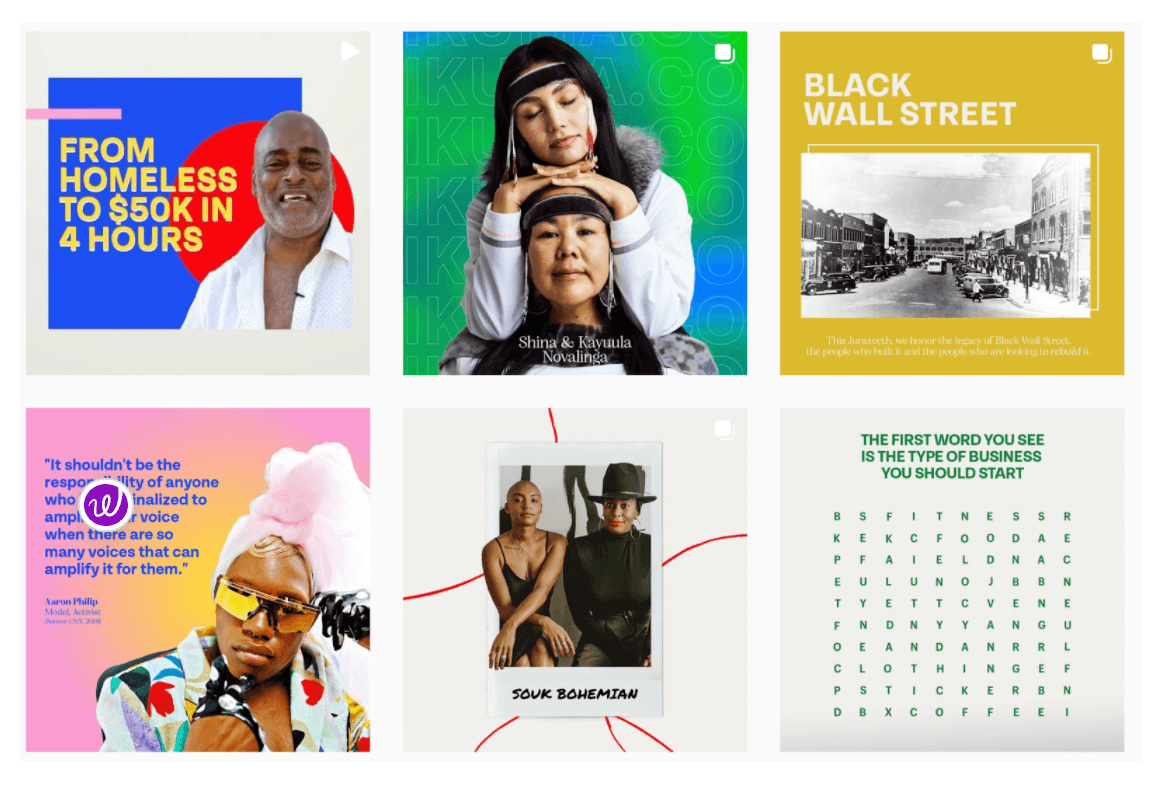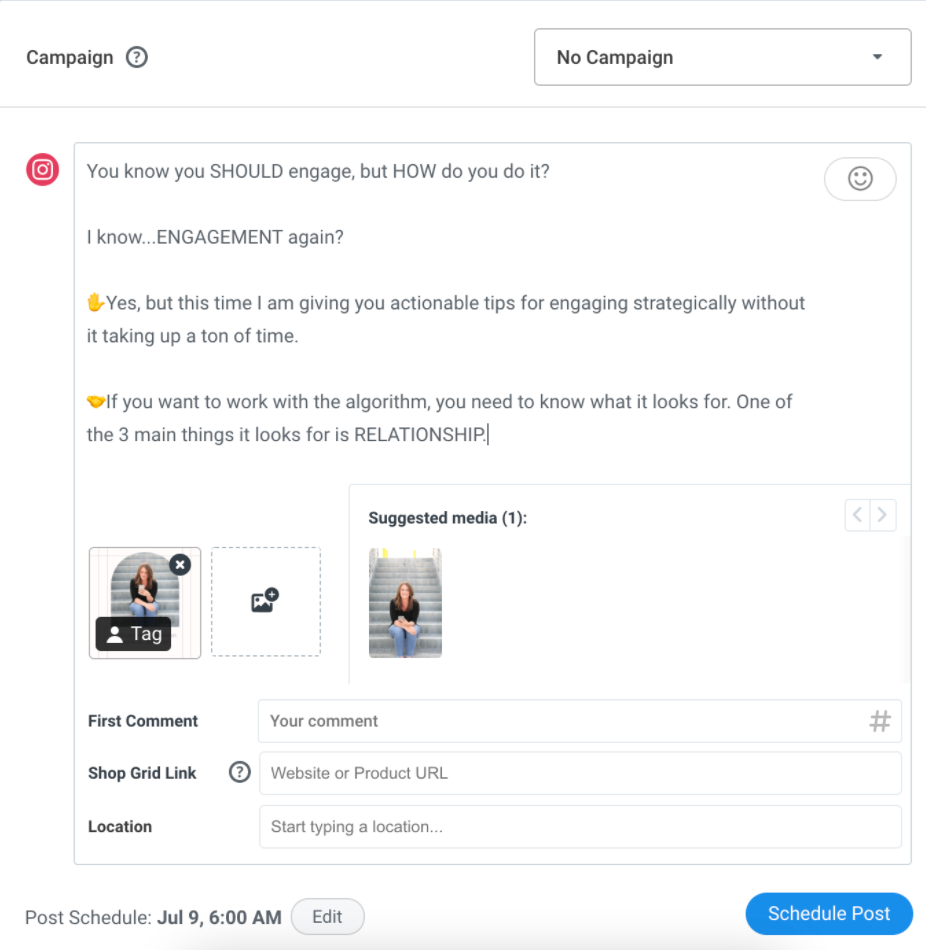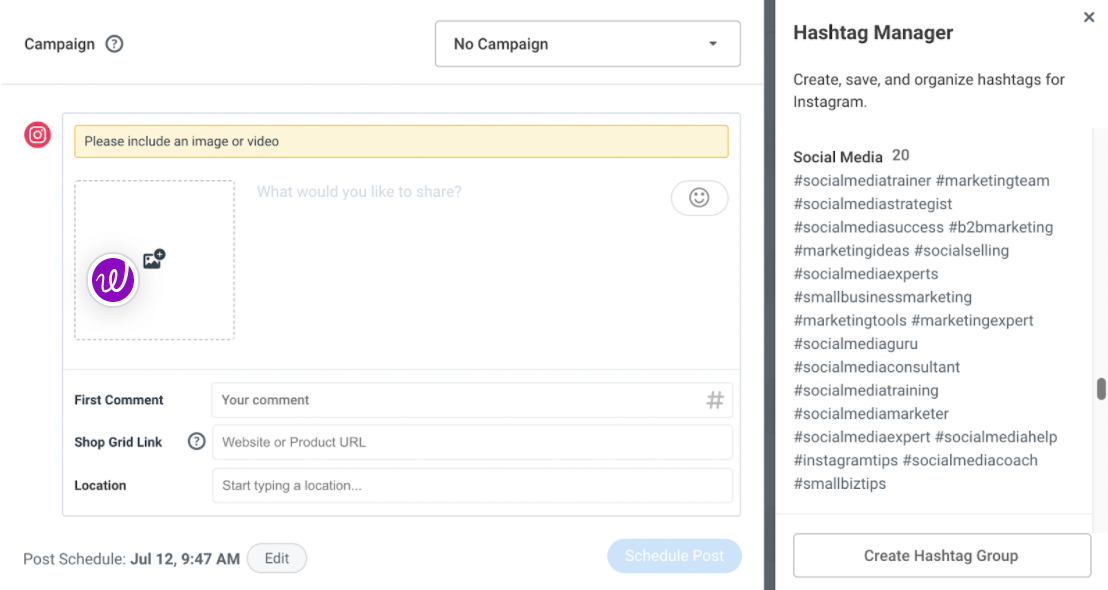
How To Save Time Planning and Creating Social Media Content
There’s no denying that content creation is time-consuming. In this post, we're sharing a sustainable strategy for saving time planning and creating social media content to help you better support your overall business goals.

Strategic Marketing Consultant @ 2Ls Marketing
There’s no denying that content creation is time-consuming. You have to think of what to post, create a graphic, write a caption, choose hashtags, post the content, and engage with your audience in the comments—and then do it all again, and again, and again.
While the challenges of social media content creation may feel daunting, showing up consistently has big benefits for your business. By posting valuable content consistently, you can:
- Grow your audience
- Increase brand awareness
- Build authority in your industry
- Improve engagement
If you are looking to achieve any of the benefits listed above, it is worth figuring out a sustainable strategy for saving time planning and creating social media content. The key to achieving this is twofold—planning in advance and batch working content creation.

Multitasking—A Cautionary Tale
Let’s take a moment to talk about something we all do—multitasking. Multitasking often feels productive because you are doing “all the things”, but in reality, multitasking is one of the least productive things you can do.
It has been estimated that only 2% of the population is actually proficient at multitasking. When you switch from task to task, it actually takes 50% longer to accomplish a task. (John Medina, Brain Rules).
“Only 2% of the population is actually proficient at multitasking.”
So what are the 98% of us that are not proficient multitaskers supposed to do? The answer—when it comes to social media content creation—is creating a system and batch working. Below is a process that you can repeat each month to save time planning and creating your social media content.
Content Planning Process
Each month, set aside time to map out your social media content for the following month. By outlining the content topics you want to cover for the entire month, you can look at your content from a higher level and be more strategic about your content plan. Plan on spending 1-2 hours each month mapping out your content for the following month.
Plan on spending 1-2 hours each month mapping out your content
Things to include in your content plan:
- Number of posts. How often do you post (or want to post) each week? Keep in mind that quality and consistency are more important than the number of posts. Stick to a schedule and frequency you can sustain long-term.
- Goals. What are your overall business goals for the month? How can your content support those goals?
- Any important dates. Do you have a new product or service launching, or an event? Plug those into your plan first, so you can fill in supporting content around them.
- Social media holidays you want to “celebrate”. Are there relevant social media holidays you want to celebrate on your social platforms? This list has a good roundup of these types of holidays, or you can always research those that are specific to your industry.
With this content roadmap, you can confidently go into the month knowing what content needs to be created each week (more on that later).
What Types of Social Media Content Should You Create?
One of the biggest challenges when it comes to social media content is knowing what to post. When creating content for social media, it is important to share a variety of types of content. Your content should educate, entertain, or sell.
Below are a few examples of businesses balancing content that educates, entertains, and sells.
Bulletproof (@bulletproof)
Bulletproof balances entertainment, education, and sales very well in their content. They highlight their products, share recipes and answer FAQS, and create funny, relatable GIFs.

Shopify (@shopify)
Shopify shares inspiring personal stories of their customers, encourages conversation and engagement by asking questions, and sharing video content with “how” and “why” motivating life hacks.

Flodesk (@flodesk)
Flodsesk highlights new features, shares tips and best practices for email marketing, and encourages engagement from their audience by asking “this or that” and “would you rather?” questions.

Another advantage of planning your content for the entire month is that you can better distribute and plan the types of content you will be sharing. Rather than scrambling to come up with something to post and potentially posting too many sales-focused posts or too many funny memes, planning in advance allows you to be more intentional and strategic with what you post. That ensures you are hitting all the marks building the know, like, and trust factor with your audience, serving them, and ultimately converting them.
Let’s say you want to share four posts per week. To balance your content types, you could share two educational posts, one sales-focused post, and one entertaining post each week. As you plan your month of content, you can start to plug in your content ideas according to that cadence and flow.
Bonus tip: This step of the process does not need to be high-tech. Simply use a monthly calendar (you can print one at Print-a-Calendar.com if you don’t have one) and grab some sticky notes and a pen and start jotting down your content topics. This process allows you to move things around as needed to better balance and distribute your content. Alternatively, you can plan in digital form on a Google calendar or in software like Asana, Trello, or Cickup. Choose the tool that works best for you so that you are more likely to use it.
When planning content, it is important to remember that content doesn’t have to be overly complicated. Really anything can be content if it is valuable to your ideal audience. Share your knowledge, take your audience behind the scenes, introduce your team, share customer testimonials or reviews, answer frequently asked questions. Know that you have insight that your audience craves—they told you that when they chose to follow you.
Streamline Content Creation With Batchworking
Let’s circle back to batch working and how to apply the tactic to content planning.
What Is Batch working?
Batch working is a highly focused, topic-specific form of working. When batch working, you divide your work into different hours/days and focus on only one thing at a time. Batch working can be applied to all areas of your life and work, but here we will focus on how to utilize it for content creation.
The idea is that by focusing on one task at a time, you can get into a flow state which is when your productivity and creativity truly flourish. The end result is better quality content in less time. A win-win!
Step 1: Plan a Month of Content
As outlined above, the first step in planning and creating social media content is to map out the entire month on content.
Assuming you have your monthly content plan and roadmap ready to go, each week you should follow the steps below to streamline the content creation piece of the puzzle.

Step 2: Create All Visual Content
With your content roadmap, decide what visuals need to be created for the week. Write a list of everything you need from stock photos, custom graphics, videos, Reels, cover images, etc.
Once you have the list, it’s time to start creating. For custom branded graphics, you can use a tool like Canva. Create (or purchase) a library of templates you can easily customize with different content each week. This keeps your branding consistent and also saves you time as opposed to starting designs from scratch each week.

Step 3: Write All Captions
Captions do not have to take a long time to create. By batching captions and following a caption formula, you can quickly write captions that convert your audience. A good caption should include:
- Hook: Grab their attention right off the bat. Think of the first 7-14 words of your caption like an email subject line. You have to inspire your audience to click “read more”.
- Value: Deliver on what you promised in your hook and share content that educates, entertains, or sells.
- Call to Action: Tell your audience what you want them to do next (i.e. share, like, comment, click, buy, sign up, tag, etc.). Keep your calls to action simple and fun to increase the likelihood that your audience will follow through.

Step 4: Schedule Posts
Now that you have your visuals and captions, it’s time to schedule your posts according to your content calendar. Using Buffer’s Publishing tool, go to Settings and set your posting schedule.

Then navigate to your queue, drag and drop images and copy/paste captions and click “Schedule Post” or “Add to Queue”. Depending on the type of post, your post will either automatically publish at the scheduled time, or you will receive a push notification at the scheduled time to post yourself.

Step 5: Add Hashtags (if posting to Instagram)
If you are posting to Instagram, when you schedule your post, you also have the option to add up to 30 hashtags to the first comment of your post. Buffer’s hashtag manager allows you to save hashtag groups right in the platform. This makes it easy to choose the right hashtag group(s) to add to your post. When used thoughtfully and strategically, hashtags are a great way to extend the reach of your content.

Enjoy The Benefits of Planning & Scheduling Your Content in Advance
Imagine not having to constantly be wondering, “What should I post?”. As you get into the habit of planning and scheduling content in advance, you will start to see your efforts pay off. Not only will your content strategy benefit you, but you will also save yourself time and reduce stress around social media content. Instead of “posting just to post”, adopting a content batching routine allows you to create high-quality content when you are in your “content zone” and schedule it according to your social media strategy.
When you plan content in advance, your content can better support your overall business goals. If you have a product or service that you want to promote, an event or a company milestone, planning in advance lets you work backward to create strategic social media content that supports those goals.
Finally, by freeing up time and energy in the content creation process, you allow yourself to spend more time in other areas of your business. That extra time can be spent building connections and relationships with your social media community, or in other areas of your business like sales, admin tasks, networking or growing your team, or even on self-care. Think about what you would spend those extra hours on each month, and use that as motivation for sticking with your new content process.
Social media is a powerful tool for businesses. By planning in advance, you can leverage social media strategically and thoughtfully.
Try Buffer for free
180,000+ creators, small businesses, and marketers use Buffer to grow their audiences every month.
Related Articles

Stop chasing the tail-end of Instagram audio trends — here are the latest trending songs on Instagram in July 2025.

We pored over millions of posts on Instagram, Facebook, Twitter, YouTube, TikTok, and LinkedIn to pinpoint when the best-performing content was published.

Learn how to leverage AI social media content creation tools and save valuable time in your social media marketing efforts.